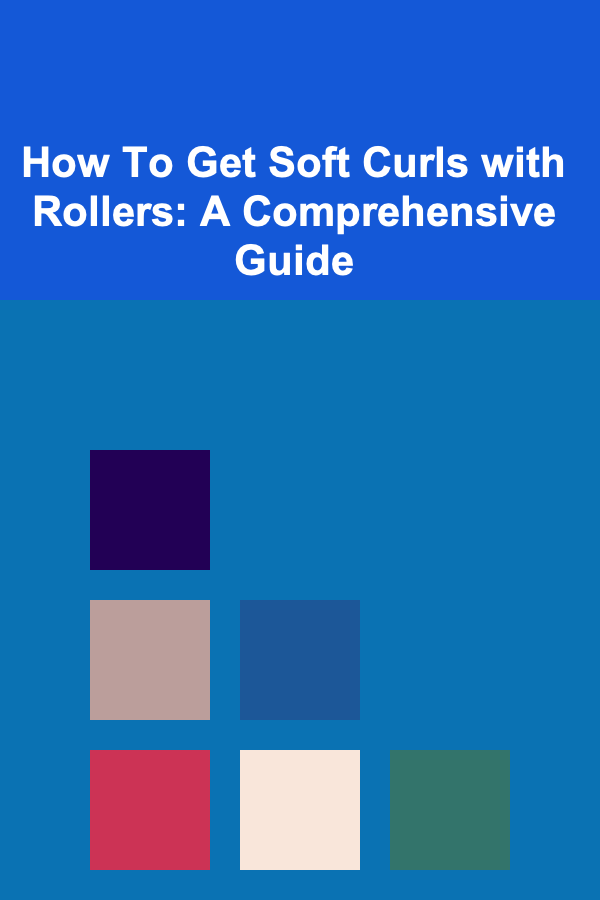
How To Get Soft Curls with Rollers: A Comprehensive Guide
ebook include PDF & Audio bundle (Micro Guide)
$12.99$10.99
Limited Time Offer! Order within the next:

Achieving beautiful, soft curls doesn't always require heat styling tools. Rollers offer a gentle, heat-free alternative that can create stunning curls with plenty of bounce and volume. This comprehensive guide will walk you through everything you need to know to achieve salon-worthy soft curls using rollers, from choosing the right type to mastering the application technique and ensuring your curls last.
Understanding the Benefits of Using Rollers
Before diving into the "how-to," let's explore why rollers are a fantastic choice for creating curls:
- Heat-Free Styling: The biggest advantage is the absence of heat. Heat styling, while effective, can damage hair over time, leading to dryness, breakage, and split ends. Rollers allow you to achieve curls without compromising the health of your hair.
- Gentle on Hair: Rollers are generally much gentler than curling irons or wands. They minimize friction and tension on the hair shaft, reducing the risk of damage.
- Long-Lasting Curls: Curls created with rollers often last longer than those achieved with heat styling. The slow, gradual process of setting the hair in rollers allows the hair's hydrogen bonds to reform in the curled shape, resulting in more resilient curls.
- Customizable Curl Size and Shape: Rollers come in various sizes and shapes, allowing you to customize the size and tightness of your curls. From loose waves to tight ringlets, the possibilities are endless.
- Adds Volume and Body: Rollers not only create curls but also add significant volume and body to the hair, making it appear fuller and more voluminous.
- Versatile: Rollers can be used on a variety of hair types and lengths, although longer hair generally benefits the most. With proper technique, you can achieve stunning results regardless of your hair's natural texture.
Choosing the Right Type of Rollers
The market offers a wide array of rollers, each with its own unique features and benefits. Understanding the different types is crucial for selecting the best option for your hair type and desired curl style.
1. Velcro Rollers
Velcro rollers are lightweight, easy to use, and readily available. They are covered in tiny hooks that grip the hair, holding it in place. They're best for adding volume and soft curls.
- Pros: Lightweight, easy to use, adds volume, affordable.
- Cons: Can snag or damage fragile hair, especially when removing. May not provide as defined curls as other types. Can create frizz if hair isn't perfectly smooth before application.
- Best for: Adding volume and soft waves to fine to medium hair.
2. Foam Rollers
Foam rollers are soft, comfortable to sleep in, and ideal for creating defined curls without heat. They come in various sizes and are held in place with a snap or strap.
- Pros: Comfortable to sleep in, gentle on hair, good for creating defined curls.
- Cons: Can be bulky, may not be suitable for very long or thick hair, can sometimes leave creases if not properly applied.
- Best for: Creating defined curls and waves, especially for those who prefer to sleep with rollers in.
3. Magnetic Rollers
Magnetic rollers are typically made of plastic with small holes that allow air to circulate, promoting faster drying. They usually require roller clips to hold them in place.
- Pros: Promotes faster drying, creates defined curls, provides good lift at the roots.
- Cons: Requires roller clips, can be uncomfortable to sleep in, may not be suitable for very fine or damaged hair.
- Best for: Creating defined curls and adding lift, particularly for medium to thick hair.
4. Hot Rollers
Although this guide focuses on heat-free curling, it's worth mentioning hot rollers. They are electrically heated rollers that create curls quickly. While not entirely heat-free, they generally use lower heat than curling irons.
- Pros: Quick and easy to use, creates defined curls and volume.
- Cons: Still uses heat, which can damage hair over time. May not be suitable for very fine or damaged hair.
- Best for: Creating quick curls and volume when time is limited. Use with caution and heat protectant.
5. Flexi Rods
Flexi rods are long, flexible foam rods that can be bent and twisted to create a variety of curl sizes and shapes. They're excellent for creating tight, defined curls, especially for textured hair.
- Pros: Versatile, can create a variety of curl sizes and shapes, good for textured hair.
- Cons: Can be time-consuming to apply, may require some practice to master the technique, can be uncomfortable to sleep in.
- Best for: Creating defined curls and coils, particularly for natural or textured hair.
6. Steam Rollers
Steam rollers are another type that utilizes a little heat, but with the added benefit of moisture. They are typically electric and heat the rollers using steam, which is thought to be less damaging than direct heat. The moisture helps to set the curls and add hydration.
- Pros: May be less damaging than traditional hot rollers due to steam, can add moisture to the hair, creates soft curls.
- Cons: Can be more expensive than other types of rollers, requires electricity, can be messy if not used carefully.
- Best for: People with dry hair who want to add moisture and curl at the same time.
Choosing the Right Size: The size of the rollers directly impacts the size of the curls. Larger rollers create loose waves and volume, while smaller rollers create tighter, more defined curls. Consider your hair length and desired curl style when selecting the roller size.
Preparing Your Hair for Rollers
Proper preparation is key to achieving long-lasting, beautiful curls. Here's a step-by-step guide to preparing your hair for rollers:
- Wash and Condition Your Hair: Start with clean, moisturized hair. Use a shampoo and conditioner that are appropriate for your hair type. Avoid heavy products that can weigh down the hair.
- Apply a Leave-In Conditioner: Apply a lightweight leave-in conditioner to detangle and hydrate the hair. This will help prevent frizz and make the hair more manageable.
- Detangle Thoroughly: Use a wide-tooth comb or a detangling brush to remove any knots or tangles. Start at the ends and work your way up to the roots.
- Apply a Setting Lotion or Mousse: A setting lotion or mousse provides hold and helps the curls last longer. Apply a small amount evenly throughout the hair, focusing on the roots and mid-lengths. Avoid using too much product, as this can make the hair stiff and crunchy.
- Allow Hair to Air Dry Slightly: Ideally, the hair should be about 80% dry before applying rollers. This helps the curls set properly and reduces the risk of damage. You can also use a diffuser on a low heat setting to speed up the drying process. Don't start rolling if the hair is dripping wet.
Step-by-Step Guide to Applying Rollers
The application technique is crucial for achieving the desired curl pattern and avoiding frizz or unevenness. Follow these steps for best results:
- Section Your Hair: Divide your hair into manageable sections. The size of the sections will depend on the size of the rollers and the desired curl size. Smaller sections create tighter curls, while larger sections create looser waves. Start with a section at the front of your head, along your hairline.
- Smooth the Section: Use a comb to smooth the section of hair, ensuring it's free of tangles and frizz.
- Position the Roller: Hold the roller at the ends of the hair section.
- Roll Upwards: Begin rolling the hair around the roller, working your way up to the roots. Keep the tension even as you roll to avoid creating bumps or kinks.
- Secure the Roller: Secure the roller in place with a clip or pin, depending on the type of roller you're using. Velcro rollers usually don't require clips.
- Repeat the Process: Repeat steps 2-5 for each section of hair, working your way around your head.
- Consider the Rolling Pattern: For a more natural look, alternate the direction of the rollers. Roll some sections away from your face and others towards your face. You can also use different sizes of rollers to create a variety of curl textures.
Rolling Patterns for Different Looks
- Classic Curls: Roll all sections in the same direction, either towards or away from your face.
- Voluminous Curls: Use larger rollers on the top sections of your head to create lift and volume.
- Face-Framing Curls: Roll the sections around your face away from your face to open up your features.
- Mixed Textures: Use different sizes of rollers to create a variety of curl textures.
Drying Time and Setting
The drying time depends on the type of rollers used, the thickness of your hair, and the humidity level. Here are some general guidelines:
- Air Drying: Air drying is the gentlest option but can take several hours. It's best to leave the rollers in overnight for optimal results.
- Diffuser: Using a diffuser on a low heat setting can speed up the drying process. Direct the diffuser at the roots to promote lift and volume.
- Hooded Dryer: A hooded dryer provides even heat distribution and can dry the hair more quickly. Set the dryer to a low or medium heat setting to avoid damaging the hair.
Important Note: Ensure that the hair is completely dry before removing the rollers. Removing them while the hair is still damp can result in limp, frizzy curls.
Removing the Rollers and Styling
Removing the rollers gently is just as important as applying them correctly. Rushing the process can lead to frizz and damage.
- Ensure Hair is Completely Dry: Double-check that the hair is completely dry before removing any rollers.
- Remove Carefully: Gently unclip or unfasten the rollers and carefully unwind the hair. Avoid pulling or tugging.
- Separate the Curls: Use your fingers to gently separate the curls. Avoid using a brush or comb, as this can disrupt the curl pattern and create frizz.
- Style as Desired: Style your curls as desired. You can leave them as they are for a natural look, or you can use a styling product to define the curls and add shine.
- Apply Hairspray (Optional): If you want to ensure your curls last even longer, apply a light-hold hairspray.
Tips and Tricks for Soft, Bouncy Curls
Here are some additional tips and tricks to help you achieve the best possible results:
- Use the Right Products: Choose styling products that are specifically designed for creating curls. Avoid heavy products that can weigh down the hair.
- Don't Over-Saturate Your Hair with Product: Applying too much product can make the hair stiff and sticky. Start with a small amount and add more as needed.
- Experiment with Different Roller Sizes: Experiment with different roller sizes to find the perfect curl size for your hair.
- Practice Makes Perfect: Don't be discouraged if your first attempt isn't perfect. With practice, you'll master the technique and achieve stunning curls every time.
- Protect Your Hair at Night: To prolong the life of your curls, sleep on a satin pillowcase or wrap your hair in a satin scarf.
- Refresh Your Curls: If your curls start to droop, you can refresh them by spritzing them with a little water and scrunching them with your fingers.
Tip: For extra volume at the roots, apply a root-lifting spray before rolling your hair. You can also over-direct the rollers at the crown, rolling them forward to create extra lift.
Tip: If you're using Velcro rollers, be extra careful when removing them. Gently peel them away from the hair to avoid snagging or breaking strands. Some people prefer to use a nylon stocking cap over the rollers before sleeping to prevent snagging.
Troubleshooting Common Roller Problems
Even with careful application, you might encounter some common problems when using rollers. Here's how to troubleshoot them:
- Frizzy Curls: Frizzy curls can be caused by several factors, including dry hair, improper application, or removing the rollers too soon. Make sure to hydrate your hair properly, apply a smoothing serum before rolling, and ensure the hair is completely dry before removing the rollers.
- Limp Curls: Limp curls can be caused by using too much product, not using enough product, or not drying the hair completely. Experiment with different products and drying techniques to find what works best for your hair.
- Uneven Curls: Uneven curls can be caused by inconsistent sectioning, improper application, or using different sizes of rollers. Ensure that you section your hair evenly, apply the rollers with consistent tension, and use the same size rollers for each section.
- Creases: Creases can occur, especially with foam rollers, if the hair isn't rolled smoothly or if the rollers are too tight. Make sure the hair is smooth as you roll and don't pull too tightly.
- Difficulty Sleeping with Rollers: Some rollers can be uncomfortable to sleep in. Foam rollers or flexi rods are generally more comfortable. Try wrapping your hair in a satin scarf or using a special pillow designed for rollers.
Conclusion
Achieving soft, bouncy curls with rollers is a rewarding and healthy alternative to heat styling. By understanding the different types of rollers, preparing your hair properly, mastering the application technique, and following the tips and tricks outlined in this guide, you can achieve salon-worthy curls without damaging your hair. Embrace the gentle art of roller setting and enjoy the beautiful, long-lasting curls that await!

Audio Engineering in the Digital Age: From Analog to AI
Read More
How to Personalize Your Online Learning Environment
Read More
How To Practice Unconditional Support
Read More
Top 10 Free Educational Resources to Enhance Your Learning
Read More
How to Build a Positive Self-Image
Read More
How to Leverage Credit Card Purchase Protection
Read MoreOther Products

Audio Engineering in the Digital Age: From Analog to AI
Read More
How to Personalize Your Online Learning Environment
Read More
How To Practice Unconditional Support
Read More
Top 10 Free Educational Resources to Enhance Your Learning
Read More
How to Build a Positive Self-Image
Read More